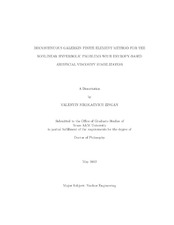| dc.contributor.advisor | Morel, Jim E. | |
| dc.contributor.advisor | Guermond, Jean-Luc | |
| dc.creator | Zingan, Valentin Nikolaevich | |
| dc.date.accessioned | 2012-07-16T15:57:52Z | |
| dc.date.accessioned | 2012-07-16T20:26:32Z | |
| dc.date.available | 2012-07-16T15:57:52Z | |
| dc.date.available | 2012-07-16T20:26:32Z | |
| dc.date.created | 2012-05 | |
| dc.date.issued | 2012-07-16 | |
| dc.date.submitted | May 2012 | |
| dc.identifier.uri | https://hdl.handle.net/1969.1/ETD-TAMU-2012-05-10845 | |
| dc.description.abstract | This work develops a discontinuous Galerkin finite element discretization of non- linear hyperbolic conservation equations with efficient and robust high order stabilization built on an entropy-based artificial viscosity approximation.
The solutions of equations are represented by elementwise polynomials of an arbitrary degree p > 0 which are continuous within each element but discontinuous on the boundaries. The discretization of equations in time is done by means of high order explicit Runge-Kutta methods identified with respective Butcher tableaux.
To stabilize a numerical solution in the vicinity of shock waves and simultaneously preserve the smooth parts from smearing, we add some reasonable amount of artificial viscosity in accordance with the physical principle of entropy production in the interior of shock waves. The viscosity coefficient is proportional to the local size of the residual of an entropy equation and is bounded from above by the first-order artificial viscosity defined by a local wave speed. Since the residual of an entropy equation is supposed to be vanishingly small in smooth regions (of the order of the Local Truncation Error) and arbitrarily large in shocks, the entropy viscosity is almost zero everywhere except the shocks, where it reaches the first-order upper bound.
One- and two-dimensional benchmark test cases are presented for nonlinear hyperbolic scalar conservation laws and the system of compressible Euler equations. These tests demonstrate the satisfactory stability properties of the method and optimal convergence rates as well. All numerical solutions to the test problems agree well with the reference solutions found in the literature.
We conclude that the new method developed in the present work is a valuable alternative to currently existing techniques of viscous stabilization. | en |
| dc.format.mimetype | application/pdf | |
| dc.language.iso | en_US | |
| dc.subject | CFD | en |
| dc.subject | Computational Fluid Dynamics | en |
| dc.subject | DG FEM | en |
| dc.subject | Discontinuous Galerkin Finite Element Method | en |
| dc.subject | Entropy | en |
| dc.subject | Viscosity | en |
| dc.subject | Entropy Viscosity | en |
| dc.subject | Finite Elements, Euler equations | en |
| dc.subject | compressible Euler equations | en |
| dc.subject | Higher-order numerical method | en |
| dc.subject | Navier-Stokes | en |
| dc.subject | deal.II | en |
| dc.subject | adaptive mesh | en |
| dc.subject | KPP rotating wave | en |
| dc.subject | CG | en |
| dc.subject | CG FEM | en |
| dc.subject | continuous Galerkin | en |
| dc.subject | artificial viscosity | en |
| dc.subject | entropy-based
artificial viscosity | en |
| dc.subject | Riemann number 12 | en |
| dc.subject | mach 3 flow | en |
| dc.subject | wind tunnel | en |
| dc.subject | circular explosion | en |
| dc.subject | forward facing step | en |
| dc.subject | Burgers' equation | en |
| dc.subject | linear transport equation | en |
| dc.subject | fluid flow | en |
| dc.subject | flow | en |
| dc.subject | fluid | en |
| dc.subject | perfect gas | en |
| dc.subject | ideal gas | en |
| dc.subject | 1D | en |
| dc.subject | 2D | en |
| dc.title | Discontinuous Galerkin Finite Element Method for the Nonlinear Hyperbolic Problems with Entropy-Based Artificial Viscosity Stabilization | en |
| dc.type | Thesis | en |
| thesis.degree.department | Nuclear Engineering | en |
| thesis.degree.discipline | Nuclear Engineering | en |
| thesis.degree.grantor | Texas A&M University | en |
| thesis.degree.name | Doctor of Philosophy | en |
| thesis.degree.level | Doctoral | en |
| dc.contributor.committeeMember | Adams, Marvin L. | |
| dc.contributor.committeeMember | Ragusa, Jean C. | |
| dc.contributor.committeeMember | Tsvetkov, Pavel V. | |
| dc.type.genre | thesis | en |
| dc.type.material | text | en |


